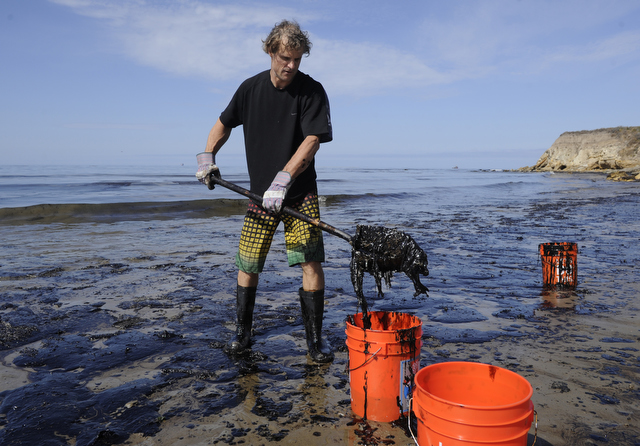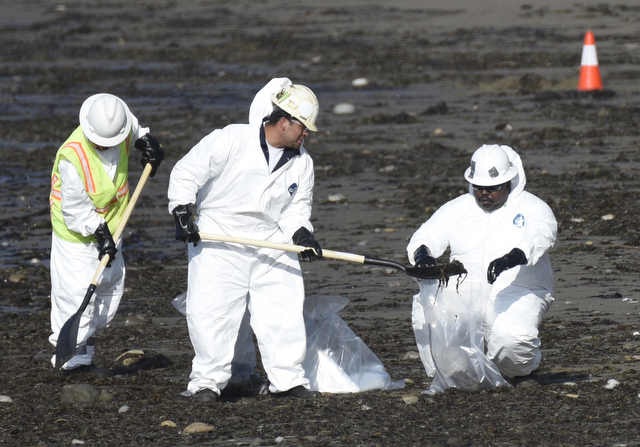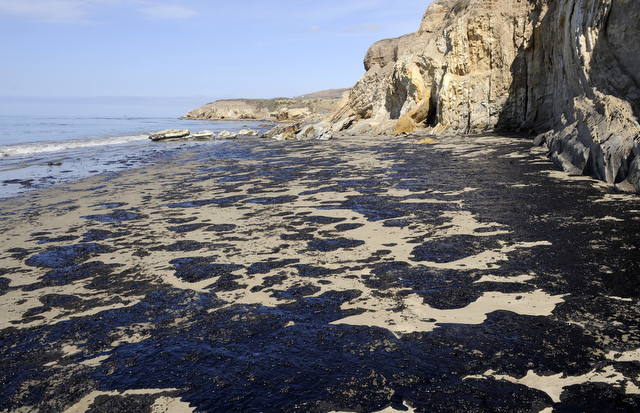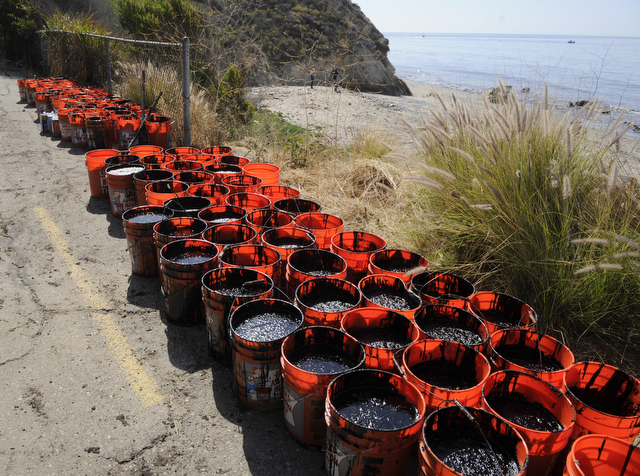
By land and by sea, cleanup crews descended Wednesday morning on the Gaviota Coast as the major oil spill from the day before grew to cover nine miles of ocean along the shoreline. Initial estimates put the spill at approximately 21,000 gallons, but officials now fear as many as 105,000 gallons of crude oil may have leaked from the broken underground pipe operated by Plains All American Pipeline. Responders are still working to pin down the exact figure and to determine how much oil seeped into the ocean.

The oil sheen has quickly spread down the coast from the spill site just west of Refugio State Beach; yesterday’s estimate put the oil slick, which has now split into two separate slicks, at four miles long with expectations it would only spread another two to four miles.
According to information just released by local, state, and federal officials operating the Joint Information Center (JIC) that is overseeing the response effort, a Plains control room employee “saw abnormalities in the line and shut it down at approximately 11:30 a.m.” on Tuesday. Initial reports from local authorities stated that county firefighters responding to smells of gas were the first to spot the leak. Plains personnel then traveled to the spill site and “visually confirmed the release at 1:30 p.m.,” the JIC dispatch reads. County officials with the Office of Emergency Management originally stated on Tuesday that an abandoned and inactive pipeline had discharged a small amount of “leftover product.”

The cause of the spill is still under investigation. The pipeline transports produced oil from ExxonMobil’s Las Flores Canyon Processing Facility near Refugio to the Plains-owned Gaviota pumping station. It shuttles an estimated 50,400 gallons of oil an hour. As of 9 a.m. this morning, vacuum trucks and skimmer boats had cleaned up approximately 6,090 gallons of oil. There are currently nine boats in the area.
According to the JIC, the pipeline’s last internal inspection was just a few weeks ago. Before that, it was assessed in 2012, but the results of those inspections are not yet available. Industry standards for internal inspections typically occur on five-year schedules.

The JIC said it’s too early to tell how much the cleanup will cost. Plains is still working with state and federal officials to determine how much public agencies will be reimbursed for the work. A claims hotline has been set up for those who believe they have been impacted by the spill: 866-753-3619.
The Attorney General’s office said it is actively working with the Santa Barbara District Attorney’s office to investigate the spill.
Refugio State Beach and its campground remain closed indefinitely. The beach and campground at El Capitan State Park are also now shut down. Sheriff’s deputies are enforcing the lockdowns. Nearby fisheries have also been closed.
Health officials are advising the public to avoid affected areas as they test air, water, and soil samples for toxicity levels. “Breathing oil fumes can cause headache, nausea, vomiting…and respiratory problems,” said Santa Barbara County Public Health Department spokesperson Susan Klein-Rothschild.
Though the Department of Fish and Wildlife has not yet released any figures or information on the impact to wildlife, witnesses have reported seeing oil-covered sea birds and dead fish along the coast. The Oiled Wildlife Care Network is conducting operations and asks anyone who sees an animal in distress to not try and help it themselves but to call 877-823-6926.
Earlier today, area resident Ethan Turpin offered this statement about his experience during Tuesday’s cleanup effort: “…[T]he 21,000 gallon estimate we are hearing seems incredibly low. I was at a cove just south-east of Refugio shooting video of the oil when some people started coming down with orange buckets and shovels. They were students who had convinced Home Depot to donate some gear for cleanup. We covered our mouths with bandanas against the fumes (not very effective) as we began filling buckets with tar. Of course, every wave that came in covered the patch of sand we’d just cleared. While I was there for about an hour we filled fifty 5-gallon buckets. Sadly, I must say there is no way we removed 1% of that spill.”
Environmentalists and politicians have lined up to condemn the spill, oil drilling in general, and what they have called the slow and inadequate response of Plains. Here is a sample of those statements:
State Senator Hannah-Beth Jackson: “Like so many of my constituents, I remain very concerned about the impact of the oil spill yesterday at Refugio Beach, the largest we have had in years in Santa Barbara County, and am continuing to monitor it closely. I commend the California State Parks, the California Department of Fish and Wildlife, the California Office of Emergency Services, the state Office of Spill Prevention and Response, the US Coast Guard and others who are working hard at the scene to respond. This is a tragic reminder of how precious our coastline and wildlife are, and the dangerous and detrimental impacts of oil drilling and oil operations. Just as the 1969 oil spill off the Santa Barbara coast spurred decades of environmental progress, I hope that this devastating situation renews our commitment to protect our coastline, and find safer forms of energy to power our state and our nation.”
Santa Barbara County Supervisor Salud Carbajal: “First responders are doing heroic work responding to this crisis by rapidly cleaning up our beaches and protecting our coastline from further damage. Right now, we need to focus our efforts on the clean-up but this is a wake up call for all of us. We must make decreasing our reliance on fossil fuels a top priority and start expanding green energy alternatives and protecting our environment by increasing safety standards with stricter oversight and increased inspections.”
State Assemblymember Das Williams: “I am deeply saddened and angered to see our beautiful Gaviota coast covered in crude oil and one of our most beloved beaches and campground closed. I am grateful for the first responders and cleanup crews who are working to limit the damage and address the mess. It is unacceptable that local people on the bluffs were the first ones to report the spill before the oil company did. We will also seek answers through a district hearing in the coming days to understand how a breach in the leak detection technology this serious could have occurred without raising alarms to the pipeline operator. We need answers to these serious questions and to find out why the response communication apparently broke down.”
U.S. Senator Barbara Boxer: “This oil spill off the Santa Barbara coast is tragic. This highlights the dangers posed by these pipelines and underscores why I have spent decades fighting against oil drilling off the California coast. I hope that by deploying all necessary resources to clean up this spill, we can prevent even greater harm to wildlife and our local communities.”
Dave Davis, President & CEO of the Environmental Council (CEC): “The Community Environmental Council is, like much of our community, feeling both shock and outrage over yesterday’s oil spill. For our founders, this is the worst type of déjà vu, recalling the 1969 oil spill over 45 years ago that spurred CEC’s formation. Sadly, we were born out of a dirty energy crisis, and we have made it our mission to transition the Santa Barbara region away from fossil fuels. Yesterday was both a step backward and a step forward in our fight to preserve the nature we love and protect the climate. The tragic Refugio oil spill off the Gaviota Coast – a unique bioregion that CEC fought successfully to protect in the 1970’s – is a sharp reminder of all that still needs to be done to defend our precious coast. Both our founders and the next generation of activists who comprise our team have been hit hard by the images of destruction, and we are feeling this spill at a visceral level.
“We are dedicated to preserving this particular coastline not just because it is the right thing to do, but because it is a place we love. Our staff knows each beach not as a name on the map, but as a place where we surf, swim, walk, and bird-watch. It is where we bring our children; the place that we call home. On a practical level, we also know that this spill could not have happened in a worse place. Oil spills are devastating no matter where they occur, but Gaviota happens to be one of only five Mediterranean ecosystems in the world. It is a pivotal bioregion between the cooler waters of the north and the warmer south, with a vibrant diversity of species not found elsewhere.”
Kira Redmond, Executive Director, Santa Barbara Channelkeeper: “Channelkeeper is sickened to learn of the oil spill in the Santa Barbara Channel and is extremely concerned about its inevitable impacts on water quality and marine life. We will be out on the water to investigate the extent and impacts of the spill, monitor the containment efforts, keep the public updated, provide any assistance we can with the clean-up, and ultimately ensure that the responsible party cleans up the oil that has marred our precious beaches, ocean and marine life.”
Link:



